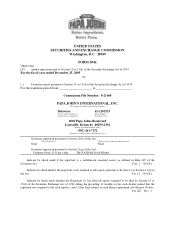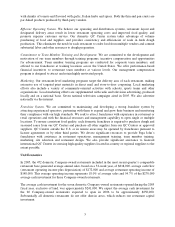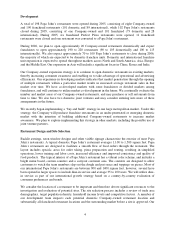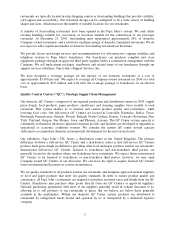Papa Johns 2005 Annual Report Download - page 5
Download and view the complete annual report
Please find page 5 of the 2005 Papa Johns annual report below. You can navigate through the pages in the report by either clicking on the pages listed below, or by using the keyword search tool below to find specific information within the annual report.3
with chunks of tomato and flavored with garlic, Italian herbs and spices. Both the thin and pan crusts are
par-baked products produced by third-party vendors.
Efficient Operating System. We believe our operating and distribution systems, restaurant layout and
designated delivery areas result in lower restaurant operating costs and improved food quality, and
promote superior customer service. Our domestic QC Center system takes advantage of volume
purchasing of food and supplies, and provides consistency and efficiencies of scale in fresh dough
production. This eliminates the need for each restaurant to order food from multiple vendors and commit
substantial labor and other resources to dough preparation.
Commitment to Team Member Training and Development. We are committed to the development and
motivation of our team members through training programs, incentive compensation and opportunities
for advancement. Team member training programs are conducted for corporate team members, and
offered to our franchisees at training locations across the United States. We offer performance-based
financial incentives to restaurant team members at various levels. Our management compensation
program is designed to attract and retain highly motivated people.
Marketing. Our restaurant-level marketing programs target the delivery area of each restaurant, making
extensive use of targeted print materials in direct mail and store-to-door couponing. Local marketing
efforts also include a variety of community-oriented activities with schools, sports teams and other
organizations. Local marketing efforts are supplemented with radio and television advertising, produced
locally and on a national basis. Seven national television campaigns aired in 2005. We also advertise
nationally via the internet.
Franchise System. We are committed to maintaining and developing a strong franchise system by
attracting experienced operators, partnering with them to expand and grow their business and monitoring
their compliance with our high standards. We seek to attract franchisees with experience in restaurant or
retail operations and with the financial resources and management capability to open single or multiple
locations. To ensure consistent food quality, each domestic franchisee is required to purchase dough and
seasoned sauce from our QC Centers and purchase all other supplies from our QC Centers or approved
suppliers. QC Centers outside the U.S. or in remote areas may be operated by franchisees pursuant to
license agreements or by other third parties. We devote significant resources to provide Papa John’s
franchisees with assistance in restaurant operations, management training, team member training,
marketing, site selection and restaurant design. We also provide significant assistance to licensed
international QC Centers in sourcing high-quality suppliers located in-country or regional suppliers to the
extent possible.
Unit Economics
In 2005, the 472 domestic Company-owned restaurants included in the most recent quarter’s comparable
restaurant base generated average annual sales, based on a 52-week year, of $818,000, average cash flow
(restaurant operating income plus depreciation) of $172,000 and average restaurant operating income of
$148,000. This average operating income represents 18.0% of average sales and 54.7% of the $270,000
average cash investment for these Company-owned restaurants.
The average cash investment for the seven domestic Company-owned restaurants opened during the 2005
fiscal year, exclusive of land, was approximately $241,000. We expect the average cash investment for
the 20 Company-owned restaurants expected to open in 2006 to be approximately $250,000.
Substantially all domestic restaurants do not offer dine-in areas, which reduces our restaurant capital
investment.


















